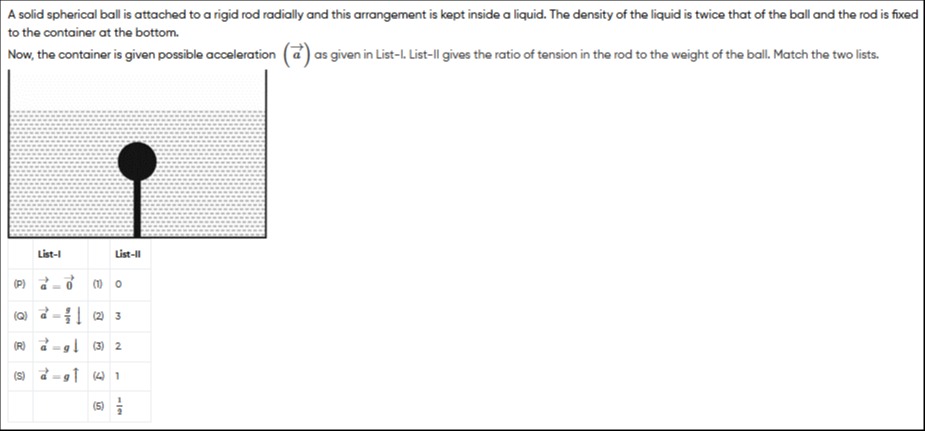Question
Question: A solid spherical ball is attached to a rigid rod radially and this arrangement is kept inside a liq...
A solid spherical ball is attached to a rigid rod radially and this arrangement is kept inside a liquid. The density of the liquid is twice that of the ball and the rod is fixed to the container at the bottom.
Now, the container is given possible acceleration (a) as given in List-I. List-II gives the ratio of tension in the rod to the weight of the ball. Match the two lists.
| List-I | List-II |
|---|---|
| (P) a=0 | (1) 0 |
| (Q) a=2g↓ | (2) 3 |
| (R) a=g↓ | (3) 2 |
| (S) a=g↑ | (4) 1 |
| (5) 21 |

(P)-4, (Q)-5, (R)-1, (S)-3
(P)-1, (Q)-2, (R)-3, (S)-4
(P)-2, (Q)-3, (R)-4, (S)-5
(P)-3, (Q)-4, (R)-5, (S)-1
(P)-4, (Q)-5, (R)-1, (S)-3
Solution
Let Wb be the weight of the ball, V its volume, and ρb its density. The liquid density is ρl=2ρb. The weight of the ball is Wb=ρbVg. The buoyant force in an accelerating frame is FB=ρlV(a−g). The net force on the ball is Fnet=FB+Wb+T=mba. Taking upward as positive, g=−gj^. The tension T is downwards, so T=−Tj^.
(P) a=0: 2ρbV(0−(−gj^))−Wbj^−Tj^=0⟹2Wb−Wb−T=0⟹T=Wb. Ratio = 1. (Q) a=−2gj^: 2ρbV(−2gj^−(−gj^))−Wbj^−Tj^=ρbV(−2gj^)⟹2ρbV(2gj^)−Wbj^−Tj^=−2Wbj^⟹Wb−Wb−T=−2Wb⟹T=2Wb. Ratio = 1/2. (R) a=−gj^: 2ρbV(−gj^−(−gj^))−Wbj^−Tj^=ρbV(−gj^)⟹2ρbV(0)−Wbj^−Tj^=−Wbj^⟹−Wb−T=−Wb⟹T=0. Ratio = 0. (S) a=gj^: 2ρbV(gj^−(−gj^))−Wbj^−Tj^=ρbV(gj^)⟹2ρbV(2gj^)−Wbj^−Tj^=Wbj^⟹4Wb−Wb−T=Wb⟹T=2Wb. Ratio = 2.
Matches: (P)-4, (Q)-5, (R)-1, (S)-3.
